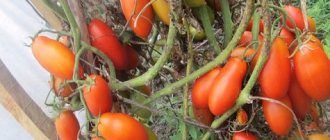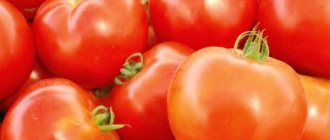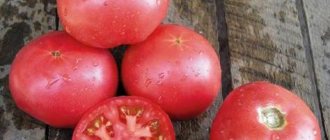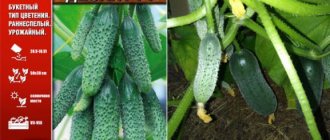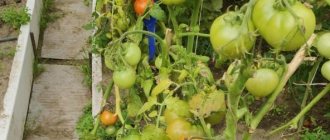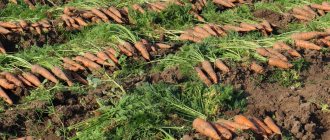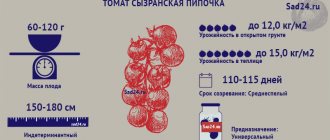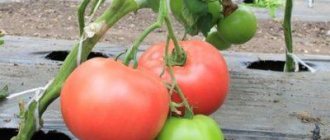Today we will tell you about an early ripening tomato variety, namely the Lakomka tomato. Many gardeners have been planting these tomatoes on their plots for a long time. This popularity arose from the fact that this variety of tomatoes is ultra early. In addition, the harvest is always rich and stable. You can enjoy the Lakomka tomato at the beginning of summer, which is why summer residents love this variety. In addition, the bushes of these tomatoes are low-growing, so they are always compactly placed on the site; the fruits are round, with a beautiful raspberry hue. The Gourmand tomato is truly versatile, as they can be eaten both fresh and processed. Housewives love to can these tomatoes. On average, the weight of one such fruit usually does not exceed 130 grams, so not only do these plants have compact bushes, but also compact plants have compact fruits that fit into the neck of the narrowest jars. Carefully study this article, and we will introduce you to a description of the variety, the advantages and disadvantages of Lakomka, as well as the rules for growing the crop.
Tomato Gourmand: photo of variety
Brief information about the variety
- Fruits and bush : tomato is dark crimson in color, average weight - 100-120 g. The bush is short - maximum height is 0.5-0.6 m.
- Productivity : with good care, 6-7 kg of fruit can be harvested from a 1 m² bed.
- Resistance : The plant is resistant to blossom end rot, but may be susceptible to other viral and fungal infections.
- Distribution : in the Krasnodar region, Astrakhan region and Kuban, this variety is grown in open ground. In the Leningrad and Moscow regions, as well as in Siberia, the seedling method is used, followed by planting plants in a greenhouse.
- Application : canning for the winter in its entirety. Delicious salads, sauces, adjika, lecho, and juice are also prepared from the fruits.
- Planting : growing by seedling method. The optimal time for sowing seeds for seedlings is the last days of March for subsequent planting in a greenhouse, the beginning of April - in open ground. Scheme – 50×60.
- Soil : fertilized with organic matter.
- Care : watering - regularly (as the soil dries), loosening, pinching, fertilizing with mineral and organic preparations - mandatory.
- Ripening period : the fruits ripen together, fruiting is prolonged - from the first ten days of June to the beginning of August. The fruits are stored for up to 1.5 months.
Characteristic
Due to the similarity in names, this tomato variety can be confused with Black Gourmet. The latter is distinguished by the pomegranate color of the fruit. The size and shape of the vegetables are the same as the variety in question.
The second difference is that Black gourmet is an indeterminate plant, its height reaches 1.8-2 m. It also belongs to mid-season crops: its fruiting occurs at the end of June or beginning of July. The variety is suitable for planting only in greenhouse conditions.
Description of the bush
According to the description of the Lakomka tomato, its bush has the following characteristics:
- the plant belongs to low-growing varieties of tomatoes - its maximum height is 0.5-0.6 m;
- branching and foliage are average;
- non-standard variety;
- flowering is abundant - the first flowers form above the 8th or 9th leaf, then every 2 leaves.
Fruit
The characteristics of the fruit are as follows:
- round tomato;
- the pulp is tender and juicy;
- thin skin;
- after the onset of full biological maturity, tomatoes acquire a dark crimson or burgundy color over the entire surface, incl. and in the area of the stalk;
- the pulp contains a small amount of seeds;
- medium weight tomato – 100-120 g;
- The taste is delicate, sweet, the aroma is rich.
Productivity
With good care, you can remove 6-7 kg of fruit from a 1 m² bed. Gourmand tomatoes ripen smoothly, bearing fruit for a long time - from the first ten days of June to the beginning of August.
Application
The small fruits are perfect for canning for the winter in their entirety. They are also used to prepare delicious salads, sauces, adjika, lecho, and juice. Tomatoes of this variety are added to side dishes.
Growing regions
In the northern regions it is recommended to grow in greenhouses
In the Krasnodar Territory, Astrakhan Region and Kuban, the Lakomka tomato variety is grown in open ground. In the Leningrad and Moscow regions, as well as in Siberia, the seedling method of cultivation is used, followed by planting the seedlings in a greenhouse.
Description of the variety
Gourmand is considered a low-growing tomato. The height of the bush reaches 60 cm. The shape of the plant is semi-spreading, the number of leaves is small. In general, the bush is compact and does not require tying up.
During the growth process, several brushes are formed, the first is formed above the 8-9 leaf, the next ones - at intervals of 1-2 leaves. The fruits are raspberry-colored, round in shape, weighing about 130 g, and have a characteristic sweet tomato taste.
Interesting ! There is a black-fruited version of Gourmet - the Black Gourmet tomato, but their similarity is limited only by the name. The dark representative of the nightshade family is tall and grows up to 2 m. The percentage of sugar in the Black Gourmet tomato is 2.5 times higher than the amount of organic acids.
Features, advantages and disadvantages of the variety
Tomato compares favorably with other varieties in a number of ways:
- fruit ripening is one-time;
- resistant to pathogens of fungal and bacterial diseases;
- resistant to adverse weather conditions and lack of water;
- due to the compactness of the bushes, it does not take up much space;
- there is no need to form a bush;
- Tomatoes tolerate transportation well, as they have durable skin.
No defects were noticed during the entire growing period.
Advantages and disadvantages
The characteristics of this culture include several advantages:
- good drought resistance;
- uniform ripening of the crop;
- regardless of weather conditions, fruiting rates are consistently high;
- possibility of growing in a greenhouse and in open ground;
- the plant is resistant to blossom end rot;
- excellent taste and commercial quality;
- unripe fruits ripen well at home and are stored for 1.5 months.
Among the disadvantages of the culture are the need for gartering, pinching, as well as poor resistance to fungal and viral diseases.
Features of cultivation
One of the important conditions for successfully growing tomatoes is timely sowing of seeds. Usually this procedure is carried out 55-60 days before the seedlings are transplanted to the site. The optimal time for transplanting into a greenhouse is the last days of March, for a garden bed - the beginning of May.
Seed preparation
Successful cultivation of tomatoes of this variety depends primarily on the quality of the seeds. It is necessary to use seed that has not expired or taken from tomatoes harvested last summer.
The seeds are rejected. To do this, they are soaked in a saline solution (1 teaspoon per 1 liter of water) for 30 minutes. Then they are washed under clean water, and then dipped in a raspberry solution of potassium permanganate. The disinfection procedure is carried out for half an hour.
Instead of potassium permanganate, you can use ash or honey solution - 1 tbsp. l. substances per 1 liter of water. Some gardeners use aloe juice not only for disinfection, but also to feed seeds with useful components. The easiest way is to spray the seeds with one of the growth stimulants - Zircon or Epin.
Then the seeds are wrapped in damp gauze and sent to a warm place for pecking. They should be kept in these conditions for 48 hours. During this time, the seeds should be periodically sprayed so that they do not dry out.
Only seeds that have not been disinfected in seed farms can be soaked and germinated before sowing.
Priming
To sow Lakomka tomatoes, you can use a ready-made store-bought substrate. The second option is to prepare the soil yourself by mixing several components:
- soil from the garden - 2 parts;
- last year's manure - 1 part;
- sand – 1 part;
- sawdust - 0.5 parts.
The composition is poured with boiling water or a concentrated solution of potassium permanganate to destroy pathogenic microflora.
Planting container
You can sow seeds in any container made of plastic or wood, the main thing is that its height is at least 10 cm, and there are several holes at the bottom to drain excess liquid.
Some gardeners use seedling boxes, others use 400 ml disposable cups, peat tablets or pots. The last option is the most acceptable and profitable: you do not have to pick the sprouts.
You can prepare the soil for sowing yourself
After the seedlings have grown, they can be planted on the site together with the planting container, because Such containers can decompose in the ground.
It is advisable to use peat pots for growing seedlings of vegetables that cannot tolerate transplanting: cucumber, zucchini, pastisson, watermelon, melon. The tomato does not just easily tolerate picking and transplanting. These procedures, carried out correctly and in a timely manner, stimulate good seedling growth in the future.
Sowing technology
The soil is poured into containers, leaving a few centimeters to the edge. In the seedling boxes, dig grooves up to 1 cm deep at a distance of 5-6 cm from each other and spill with water. The seeds are placed at a distance of 3-4 cm from each other, and then sprinkled with a thin layer of sand mixed with soil (1:1).
When sowing in a disposable container, make small indentations with a pencil or pen, place 1-2 seeds in each hole, and sprinkle with soil.
The crops are irrigated with warm water, covered with transparent glass and placed in a warm place where there is no scorching sun.
Crop care
Friendly and rapid germination of seeds will depend on certain conditions:
- temperature within 23-25 °C;
- humidity at 60%;
- daily ventilation for 30 minutes;
- moistening the soil by irrigation every 2 days.
Under such conditions, sprouts will appear already on the 6-7th day, after which the shelter is removed and the crops are transferred to a cooler and well-lit room. This way, the seedlings will focus all their efforts on growing the root system and will not stretch out. After a week they can be returned to their original place.
When sowing in groups, you will need to pick the sprouts when one pair of true leaves appears on them. The crops are watered abundantly so that the soil is well softened, then each seedling is removed and, together with a lump of earth, transferred into a spacious container.
The resulting voids are filled with fertile soil (humus and garden soil mixed in equal parts).
To prevent the seedlings from dying and quickly adapt to a new place, they are fed with a urea solution (15 g of the substance per 10 liters of water). 200 ml of solution is poured under each specimen. Before planting, the sprouts are hardened in the fresh air - taken outside and kept for 1-2 hours.
Fertilizing of seedlings is carried out no earlier than 7-10 days after picking, when it has already taken root and the roots begin to work.
Harvesting and transportation, keeping quality of berries
In private farms, the berries are picked by hand, but in industrial farms, harvesting with a combine is allowed, since the density of the skin allows mechanized harvesting. Well-ripened fruits can fall off, so gardeners place synthetic fabric under the bushes on which the berries fall - this ensures the safety of the crop.
It is better to collect berries in a spacious container, placing them in several layers. The harvest can be stored for about 3 days in the refrigerator or dried or frozen for a longer period. Excellent jams and preserves are prepared from honeysuckle, reminiscent of cherry desserts in taste. Good, undamaged fruits are suitable for transportation.
Honeysuckle Gourmand is an excellent choice for those who want to delight their family with tasty, healthy berries at a time when other fruit and berry crops have not yet ripened. Without requiring special attention, even with the slightest care, the culture is ready to reward its owners with a stable, luxurious harvest.
Transplanting into a greenhouse
Tomatoes are transplanted into a greenhouse in mid-May, when the soil warms up to a temperature of 10-12 °C. The greenhouse growing method makes it possible to get an earlier harvest of tomatoes - in early or mid-June. When planting, you should consider several important rules:
- The best place to equip a greenhouse is an area with the possibility of shading during lunch hours. To do this, you can install it near tall trees with a branched crown;
- 2 weeks before planting, the area is cleared of remnants of vegetation, sprinkled with rotted manure (10 kg), sawdust (1 bucket), superphosphate and potassium salt - 100 g per 1 m². Then digging and leveling are carried out;
- dig holes at a distance of 50 cm from each other, with a distance of 60 cm in a row. Water them with water, plant tomatoes, cover them with soil and hill them up. Near each plant, stakes are installed for support;
- To avoid infection with diseases and for full growth, bushes require stable heat - within 20-23 ° C, humidity -45-60%. The greenhouse must be ventilated periodically (once a day for half an hour).
The greenhouse should be placed in a well-lit area, away from large trees that will create shadows and, in the event of strong winds, can break the roof of the greenhouse with fallen branches. You can shade the greenhouse during the hottest period of summer with white non-woven material, shade nets, and whitewashing the roof of the greenhouse with lime.
Transplanting to a garden bed
The best place for planting tomatoes is a sunny area on a slope, protected from the winds. The bed is prepared in the fall - sprinkled with the same composition as the plantings in the greenhouse. Then they dig it up.
2 weeks before transplanting, the soil is irrigated with a urea solution (15 g per bucket of water) to destroy all pathogenic microflora, then the soil is dug up and leveled. Dig holes according to a 50x60 cm pattern, water them with water and plant the bushes.
Urea (carbamide) is a nitrogen fertilizer. It is used mainly for feeding. To disinfect plant residues in the autumn, you can use a 3-5% urea solution (300-500 g per 10 liters of water).
After planting for several days, the tomatoes are protected from the sun during lunch hours. Also, the bed is covered with film at night to avoid freezing of the bushes.
Soil preparation
The soil needs to be prepared for planting in the fall. The soil is dug up and all weeds are removed from it. It is important to choose the right site. Gourmand will grow poorly in marshy soils that are poorly ventilated and suffer from a deficiency of nutrients.
Gourmet corn loves light sandy soil, as well as calcareous and marl rocks. They heat up quickly in the spring, but their only drawback is moisture deficiency. To avoid the need for additional watering, you can give preference to medium loamy areas. Swampy and clayey soils are not suitable for growing crops.
Rules of care
Plants need fertilizers
Basic care for tomatoes in protected and open ground is the same:
- a week after transplanting, the tomatoes are watered at the root with settled water. Watering is carried out regularly and as the soil dries out. It is mandatory to water the plants during the period of flowering and fruiting, which has a positive effect on the quality of fruiting. After it, the soil is loosened, weeded, the bushes are covered with garden soil and sprouted weeds are removed;
- To obtain beautiful and large fruits, this variety requires fertilizing. The first feeding with a solution of urea or nitrophoska (15 g of substance per 10 liters of water) is carried out 2 weeks after transplanting the seedlings. At the beginning of the budding period, the bushes are watered with a solution of superphosphate and potassium salt (15 g per bucket of water). 0.5 liters of fertilizer is poured under one plant. Repeated feeding of the bushes with this composition is carried out during the filling and ripening of the fruits. To improve the quality of flowering and fruiting, the bushes are additionally sprayed with a solution of boric acid (0.2 g per 1 liter of warm water (55-60 °C)). They need to be sprayed twice - before flowering and a week after it;
- To obtain a larger harvest, pinching is carried out. After the first flower cluster appears in the lower part of the stem, all stepsons are removed so that the crop puts all its energy into the formation of large fruits;
- To prevent diseases, the bed is sprayed twice with Fundazol, HOM or Skor: the first time 20 days after transplanting the tomatoes, the second time at the beginning of flower formation. For spider mites, aphids, and whiteflies, use “Aktellik”, “Aktaru” or “Karate”. To protect against the invasion of parasites, the rows are sprinkled with ash or spicy crops (mint, garlic, onions) are planted.
How to properly care for the variety
In caring for potato plantings, the main activities are:
- carrying out hilling;
- loosening the soil around the bushes;
- weeding beds from weeds;
- fertilizing;
- Preventive treatment of plants against diseases and pests.
Features of watering
Watering potato bushes is carried out as needed. Potatoes really need moisture during the period of bud formation and flowering, since it is at this time that the number of tubers in the bushes is laid. If the weather is rainy, then watering is not necessary. If the summer is hot and there is very little rainfall, then the bushes are watered twice a week.
Each bush will require approximately 2-3 liters of water. It is better to water in the evening, and preferably between the rows, this will help avoid washing off the water around the bushes and protect the roots from being exposed.
Feeding and fertilizing
Organic matter can be used as fertilizers: manure, chicken droppings, compost, humus. It is preferable to apply such fertilizers to the soil in the fall, or in the spring two to three weeks before planting potatoes.
Common mistakes when growing
Growing this variety does not always bring gardeners the expected results; the reasons for this may be the following gardener mistakes:
- use of low-quality seed material (expired, infected with infections);
- planting in a container that is too small, in which the sprouts begin to stretch, turn yellow and die;
- the use of heavy, poor and acidified soil for sowing, as a result of which the percentage of seed germination decreases;
- injury to sprouts during picking - this is possible if they are transplanted without prior watering;
- lack of hardening before planting in the garden - such seedlings can quickly wither, turn yellow and die;
- non-compliance with the regimes of watering, loosening and feeding the bushes during cultivation in greenhouse or outdoor conditions.

